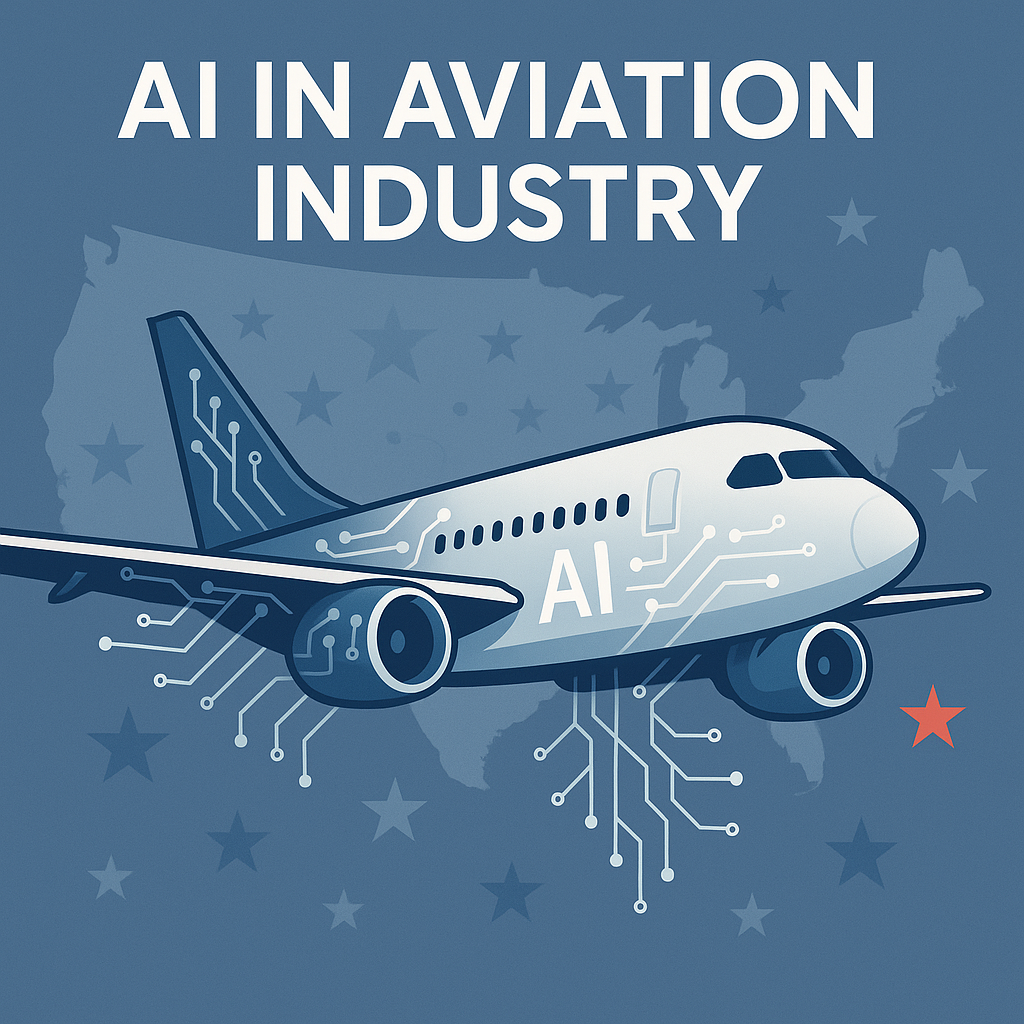
AI in Aviation Industry: Transforming the Future of Air Travel in 2025
The aviation industry is soaring into a new era, powered by artificial intelligence (AI). As we move through 2025, AI in aviation industry applications are revolutionizing everything from flight operations to passenger experiences. In this comprehensive guide, discover how AI is reshaping the skies, the top use cases, benefits, challenges, and what the future holds for U.S. airlines and travelers.
How AI in Aviation Industry is Revolutionizing Air Travel
AI in aviation industry settings is no longer a futuristic concept—it’s a present-day reality. Airlines, airports, and aerospace manufacturers across the United States are leveraging AI to optimize efficiency, safety, and customer satisfaction. Here’s how AI is making a difference:
- 🏥 Enhanced Safety: AI-powered predictive maintenance and real-time monitoring reduce risks.
- 📦 Operational Efficiency: Automated scheduling, route optimization, and baggage handling streamline operations.
- ✅ Personalized Passenger Experience: AI chatbots, facial recognition, and smart recommendations improve traveler satisfaction.
Top 10 AI Applications in the Aviation Industry (2025)
AI in aviation industry operations covers a wide spectrum. Here are the top 10 applications making the biggest impact in 2025:
- Predictive Maintenance
- Flight Operations Optimization
- AI-Powered Air Traffic Control
- Passenger Service Chatbots
- Facial Recognition for Security
- Smart Baggage Handling
- Dynamic Pricing and Revenue Management
- In-Flight Personalization
- Weather Prediction and Disruption Management
- Pilot Assistance and Training Simulations
Side-by-Side Comparison Table: Top 10 AI Applications in Aviation
| Rank | AI Application | Main Benefit | Example Use Case |
|---|---|---|---|
| 1 | Predictive Maintenance | Reduces downtime | Engine health monitoring |
| 2 | Flight Operations Optimization | Saves fuel, time | Route planning |
| 3 | AI-Powered Air Traffic Control | Increases safety | Automated conflict detection |
| 4 | Passenger Service Chatbots | Enhances customer service | 24/7 flight info support |
| 5 | Facial Recognition for Security | Speeds up boarding | Automated ID verification |
| 6 | Smart Baggage Handling | Minimizes lost luggage | AI tracking of bags |
| 7 | Dynamic Pricing and Revenue Management | Maximizes profits | Real-time fare adjustments |
| 8 | In-Flight Personalization | Improves passenger comfort | AI-driven entertainment choices |
| 9 | Weather Prediction & Disruption Mgmt | Reduces delays | AI-based weather forecasting |
| 10 | Pilot Assistance & Training Simulations | Boosts pilot readiness | AI-powered flight simulators |
TIP: Airlines adopting multiple AI applications see the greatest improvements in efficiency and customer satisfaction.
Predictive Maintenance: Reducing Downtime and Costs
One of the most valuable uses of AI in aviation industry operations is predictive maintenance. By analyzing sensor data from aircraft components, AI systems can predict potential failures before they occur.
Example: Predictive Maintenance Workflow
1. Sensors collect real-time data from aircraft engines.
2. AI algorithms analyze data for anomalies.
3. Maintenance teams receive alerts for proactive repairs.
4. Aircraft downtime is minimized, and safety is enhanced.
TIP: U.S. airlines using AI-driven predictive maintenance in 2025 report up to 30% reduction in unscheduled maintenance events.
AI-Powered Air Traffic Control: Safer, Smarter Skies
AI in aviation industry air traffic management is transforming how flights are coordinated. Machine learning models process vast amounts of flight data to optimize routes, prevent conflicts, and manage congestion.
- 📦 Automated Conflict Detection: AI identifies potential mid-air conflicts faster than human controllers.
- ✅ Dynamic Routing: Real-time adjustments reduce delays and fuel consumption.
Passenger Experience: AI Chatbots and Facial Recognition
AI is elevating the passenger journey from booking to boarding:
- AI Chatbots: Provide instant answers to flight queries, rebooking, and baggage tracking.
- Facial Recognition: Speeds up security checks and boarding, reducing wait times.
Example: AI Chatbot Conversation
Passenger: "What gate is my flight?"
AI Chatbot: "Your flight to Chicago departs from Gate B12 at 3:45 PM."
TIP: In 2025, over 70% of major U.S. airports use AI chatbots to assist travelers.
Dynamic Pricing and Revenue Management
AI in aviation industry pricing strategies enables airlines to adjust fares in real time based on demand, competition, and market trends.
- 📦 Real-Time Fare Adjustments: AI analyzes booking patterns and competitor prices.
- ✅ Maximized Revenue: Airlines can fill more seats at optimal prices.
Weather Prediction and Disruption Management
AI-powered weather forecasting tools help airlines anticipate and manage disruptions:
- Advanced Forecasting: Machine learning models predict severe weather with higher accuracy.
- Proactive Rebooking: AI systems automatically rebook passengers during delays.
Challenges of Implementing AI in Aviation Industry
While the benefits are significant, there are challenges to widespread AI adoption:
- Data Security and Privacy: Protecting sensitive passenger and operational data is critical.
- Integration with Legacy Systems: Many airlines must upgrade old infrastructure to support AI.
- Regulatory Compliance: Meeting FAA and TSA requirements for AI-driven processes.
TIP: Collaborate with aviation regulators early to ensure smooth AI integration.
The Future of AI in Aviation Industry: What to Expect by 2030
Looking ahead, AI in aviation industry applications will continue to expand:
- Autonomous Aircraft: AI will play a key role in pilotless commercial flights.
- Hyper-Personalized Travel: AI will tailor every aspect of the passenger journey.
- Sustainable Aviation: AI will optimize fuel use and reduce emissions.
Conclusion: AI in Aviation Industry is Shaping the Future of Air Travel
AI in aviation industry operations is no longer just a buzzword—it’s a transformative force in 2025. From predictive maintenance and smarter air traffic control to personalized passenger experiences and dynamic pricing, AI is delivering safer, more efficient, and more enjoyable air travel across the United States. While challenges remain, the benefits far outweigh the hurdles. As AI technology continues to evolve, expect even greater innovations that will redefine the future of aviation for airlines, airports, and travelers alike. The sky is truly the limit for AI in the aviation industry!